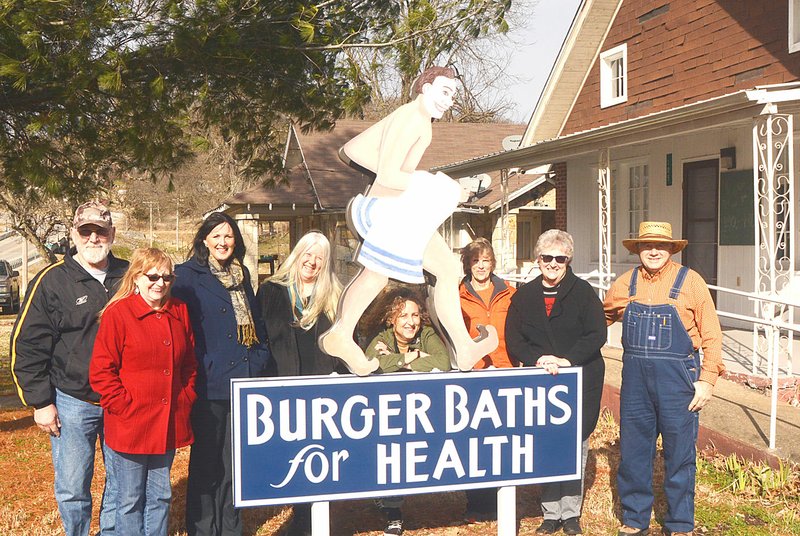SULPHUR SPRINGS -- Some people have asked why the half-naked man, wearing only a towel around his waist, stands outside on the Sulphur Springs Museum's front lawn. The simple answer is that he is an original figure from the town's history.
Travelers driving through Sulphur Springs along the original U.S. Hwy 71 during the 1930s through the 1960s might recognize the man standing on the sign. They might remember the original sign beneath the man that advertises the Burger Bath House, an early day spa and massage parlor opened by Frank A. Burger.
It was early 1920 when Mr. Burger and his wife Ann moved to Sulphur Springs from Walnut, Kan. He first established himself as a merchant by investing in the town's lots and putting them up for resale. He built his home next to his bathhouse along what was then Highway 71. Both structures still stand today. The Burger Bath House is now the community's museum building.
The original sign that stood on the highway side of the sidewalk had a similar half-naked man draped by a similar towel. The sign's mission today is to bring attention to the museum's collection of objects and artifacts telling the story of the historical significance of Sulphur Springs in the region's settlements and development.
Why did museum commissioners vote to have the original sign reproduced? The answer is simply to gather attention. They hope it draws an eye for those interested in the town's historical significance, which began before the 1840s when earlier settlers came to homestead the valley in which Sulphur Springs is located today.
Before white settlers came, many native tribes' peoples enjoyed the valley's healing springs and spiritual quality. By its natural spiritual nature and abundance of wildlife for food, fresh clean water to drink, and a natural lake probably first built by beavers, it isn't hard to imagine why the first people of America came to this valley to hold their powwows.
Similar to today's excursion trains that travel from Rogers to Van Buren, Sulphur Springs, during its "hay day" of the mid-1880s through the early 1900s, enjoyed the Kansas City Southern stop and turnabout, bringing up to 750 people a day to Sulphur Springs and taking them back north through Splitlog and Joplin, Mo., and back to Kansas City. Sulphur Springs became the first town in western Benton County to have a KCS railroad station and once had four tracks beside it.
During a period stretching from the late 1880s until about 1910, thousands of visitors hopped on the Kansas City Southern rail lines to travel south to Arkansas. Their trip to Sulphur Springs allowed them to discover a healing touch on a hard life compared to today. The healing spring waters of Sulphur Springs served up hot baths, with massages available at an added cost. As many as seven major hotels and dozens of bed and breakfast houses served up fine meals. The then 10-acre lake served to cool hot bodies on summer days, as well serve as a nice place to take a free bath.
Doctors' orders pushed visitors with many types of ailments to travel long distances to get to Sulphur Spring's healing spring water and bathhouses. Many came to vacation in the city's cool valley from the prairie lands of Kansas and flatlands north of Anderson in Missouri.
Members of the museum commission salute all who invest their time, efforts and money to create and maintain the museum's collection. The museum is open twice a month on the second and fourth Saturdays, from 1:30 to 4:30 p.m. One or more of the museum commissioners or its coveted members will be there to answer questions about the town's high points in Arkansas' history.
General News on 04/24/2019
